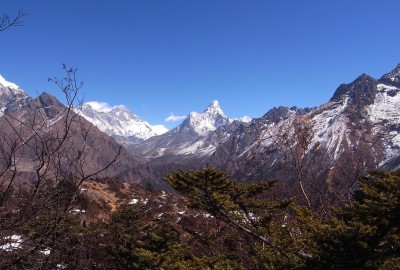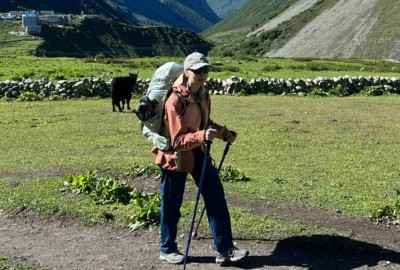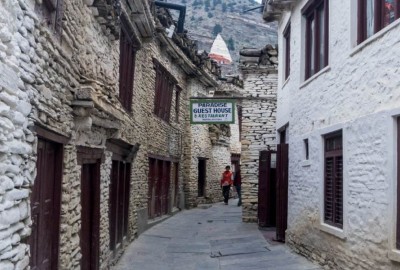Janakpur, famously known to be the birthplace of Goddess Sita and the place where she married Lord Ram. It is a city located in the Terai region of Nepal. It is also the administrative headquarters of the Dhanusa district. It is also fondly known as the city of ponds as it holds more than seventy different ponds within its luscious landscape.
Table of Contents
Plan your trip to Nepal
Customize your trip with help from a local travel specialist.
The Ramayana and its importance today can be learned here and thousands of tourists and pilgrims from all around the world come here to visit this holy Hindu city. The auspicious and colorful festivities that go on throughout the year, the pleasant weather, the friendly locals, and the stunning design of the temples makes Janakpur a well-liked spot for both pilgrims and tourists alike.
The culture of Janakpur is mostly of Indian heritage, and it was also the capital of the ancient kingdom of Mithila. The territory of which has now been divided between India and Nepal. The number of Maithili speaking people today is more than 2 million and they are famous for their vividly colorful paintings.
History of Janakpur
According to the Hindu myths of Ramayana, the original city of Janakpur was named after the ruler of Mithila kingdom, King Janak. It is said that baby Sita was found by the king in a furrow of a field. He adopted her and raised her as his own daughter. When Sita(also known as Janaki) turned 16, King Janak announced that whoever was able to string the divine bow of Shiva would be the one to marry Sita. Although many royal suitors tried to string the divine bow, only the prince of Ayodhya, Lord Rama was successful. Not only did he string the bow, but he also snapped it in two too. And thus, Lord Rama was to be wed to Sita.
Between the tenth and the third century BC, Mithila kingdom controlled a large part of Northern India when it came under the control of the Mauryan Empire (321 to 185 BC) according to historical sources. The two great Mauryan Empires liked the religions of Buddhism and Jainism, and both the great saints Vardamana Mahavira (the 24th and final enlightened sage) of the Jain religion and Gautama Buddha (Founder of Buddhism) are said to have lived in Mithila. Until the seventeenth century, Janakpur languished as a religious site for over two millennia after the decline of the Mauryan Empire.
People of Janakpur
Dhanusha district is filled with a diverse range of ethnic groups such as Kayastha, Yadavs, Tharu, Teli, Brahmins, Chhetris, Musahar, and Rajput. They are the main inhabitants of the villages around Dhanusha and farming is their main form of livelihood. The whole region is regarded as the center of Mithila culture, hence Mithila culture and art prevail in this region.
Places to Visit in Janakpur
Janaki Mandir
At the exact place where she was born, the great saint and poet Sannyasi Shurkishordas discovered a golden statue of the Goddess Sita in 1657. Ultimately it became the location of the current Temple of Sita, Janaki Mandir. The founder of modern Janakpur is considered to be Shurkishordas.
In 1911, Queen of Tikamgarh, Brisabhanu Kunwari built the Janaki Mandir. The temple's architecture is quite unique in Nepal as the flower-bedecked statue of Sita which was miraculously found in the Saryu River near Ayodhya is in the inner sanctum. The statues of Rama and his half brothers Lakshman, Bharat and Shatrughan are next to Sita. The temple is lit with vividly bright lights and filled with pilgrims expressing their devotion to Sita and Rama during early mornings, so it is the best time to visit the temple. Women wear their best clothes when they come to visit this temple. Next to Janaki Mandir is the monument that marks where Sita and Rama were married.
To pay homage to Sita at the time of Vivah Panchami, tens of thousands of pilgrims visit Janakpur. Vivah Panchami is the day of the marriage of Sita and Ram and falls on the fifth day of Shukla Paksha (waxing moon of November/December). They also visit the temple during Ram Navami (the birthday of Lord Rama) which falls on the ninth day of the Hindu month of Chaitra (begins with the new moon in March/April).
Ram Mandir
Ram Mandir is located about a 10-minute walk away from Janaki Mandir, right opposite to Dhansagar. Many stone idols of Lord Shiva are scattered on the right side of the temple.
Ram Mandir is mostly visited during the Ram Navami and Vivah Panchami. Special bhajans are sung on the day as Ram Navami is the birth date of Ram. Between Ram Mandir and Janaki Mandir special traditional marriage rituals are performed as codes that have to be followed during Vivah Panchami. During the Dashain festival, the Rajdevi Temple which is nearby is lavishly decorated.
Thousands of goats are sacrificed in the name of Goddess Rajdevi on Maha Ashtami which is the 8th day of Dashain. According to the people who have visited the temple as well as the locals, the daytime is for worshipping the temple while the nighttime is to revel in its beauty.
Gangasagar (pond)
Regarded as the holy pond in Janakpur, Gangasagar gets its name from the words Ganga and Sagar. While Ganga translates to the holy river in India, Sagar means Pond which means the water from this pond has been brought in from the Ganga. Prayers are performed on the river banks during the night which makes the pond worth watching. There is a special chanting done while praying. Visitors are allowed to go for a boat ride even during the aarti time. Next to it is the Ratnasagar which translates to one pond. In November and April during the Chhath festival, the temples are beautifully decorated.
Swargadwari
Located on the west bank of Gangasagar, formerly Swargdwari used to be a cemetery but now it has been turned into a picturesque park bedecked with flowers and is home to a small Hindu temple. The name Swargadwari is comprised of two words Swarg and Dwar. Swarg translates to heaven and Dwar translates to gate. This place is considered as a gate to heaven for dead people.
Dhanushadham
Dhanushadham plays a prominent role in the Ramayana and it is located approximately 13 kilometers from Janakpur. According to the myths, pieces of the bow fell into Dhanushadham when Ram broke the divine bow in order to win Sita’s hand for marriage. Another pond having religious history, Parsuram Talau lies on the route to Dhanushadham from Janakpur. A concrete snake structure and a nearly 20 foot high Shiva idol is in between the pond.
Nari Bikas Kendra
Nari Bikas Kendra translates to Women Development Center. This nonprofit center is working on providing a safe and supportive space for women from the Janakpur area and helping them to develop their skills so that they can earn their livelihood and become independent. This has resulted in many women going to start their own business due to the artists' cooperative. Literacy skills, as well as business training, are taught by the center. This center also has no judgment support sessions in which women can debate their roles in family and society. While initially, this place specialized in the Mithila region's typical paper art, it has now broadened it into sewing, ceramics, screen printing and painting.
Mani Mandap
This is regarded as the original Vivah Mandap of Lord Rama and Goddess Sita and it lies in the Mujelia area of Janakpur. There is a big area of soil-filled land and a very small temple structure. In front of it is the Paisarni Sagar, where it is believed to have washed Lord Rama’s feet before sitting in the Vivah Mandap. Nature surrounds the whole place and a small village lies nearby.
How to Get to Janakpur
Dhanusadham is in the Janakpur Zone in the Dhanusha district. Janakpur is approximately a 10-hour drive away from Kathmandu and 390 km away. You can find buses that leave for Janakpur, Dhanusha's headquarters at Gongabu in Kathmandu. You can also get a flight that directly leads to Janakpur. It takes about 40 minutes to get there from Kathmandu by air. Dhanushadham is 18 kilometers away from Janakpur and an hour’s drive away. You can get public transportation that goes to Dhanushadham from the city area.
Food & Accommodation in Janakpur
Janakpur has a series of luxurious hotels and many restaurants of different varieties that carter to the needs of visitors. Accommodation for pilgrims (Dharamshalas) is also available. The food has an Indian touch and tastes delicious, it caters to a large number of Indian visitors. There are vegetarian dishes and sweets available too.








